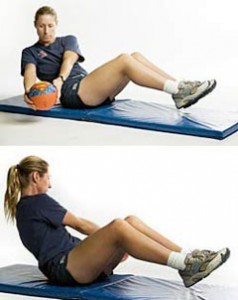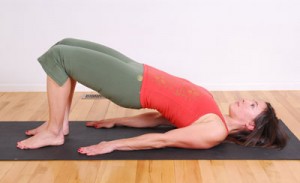How Postpartum Moms Can Correct Diastasis
 I’m here with women’s fat loss expert Holly Rigsby from ClubFYM.com, and if you’ve been following along over the past week then you’ll know that we’ve been going over exactly how to help postpartum women reclaim their bodies, covering everything from excess fat, to loose skin, to stretch marks. There’s been a lot of really insightful information passed along, so if you’ve missed it, please feel free to check out part 1, 2, and 3.
I’m here with women’s fat loss expert Holly Rigsby from ClubFYM.com, and if you’ve been following along over the past week then you’ll know that we’ve been going over exactly how to help postpartum women reclaim their bodies, covering everything from excess fat, to loose skin, to stretch marks. There’s been a lot of really insightful information passed along, so if you’ve missed it, please feel free to check out part 1, 2, and 3.
Today is no exception, however, as we’ll be talking about a problem that keeps many unknowing women from ever obtaining a flat stomach postpartum. Read on to learn more…
*********************
Craig Ballantyne: Okay, another big problem that women have is the diastasis, the separation of the abdominal muscles through the pregnancy.
I know this causes some discomfort and it can also oddly shape the abdominals and obviously it’s going to cause you weakness as well when you get back to training with people.
What is something women can do about that, some solutions, some exercises, anything we can do to help the listener?
Holly Rigsby: Absolutely, yes. It’s funny how we had discussed this earlier, Craig, but all of a sudden now I’ve been getting a lot of questions about this too. It’s like the HOT TOPIC.
I think it’s just AWARENESS of it, because a lot of women they are committed to their fat loss plan, they have reduced their body fat, they’re back in their skinny jeans, but there is this bulge on their belly. They’re like, “What can I do? I’m eating clean, here are my food logs.” I’m like, “You’re right, you are.”
Understanding that yes, this is something that happens during pregnancy as your uterus grows it pushes against the abdominal wall, in addition to your pregnancy hormones softening that connective tissue, so it’s going to cause your organs to protrude and it leads to weaknesses, lower back pain, and of course the frustration of not being able to achieve a flat tummy no matter how much you’ve refined your nutrition plan and no matter how consistent you are with your workouts.
How do you know if you have it?
Because I know a lot of women are probably like, “Well, maybe that’s what my problem is.” Well, you can do a quick SELF TEST, and there’s a series of steps here:
1. First of all, you’ve got to lie on your back, knees are bent, feet flat on the floor.
2. Place one hand behind your head and the other on your abdomen. With your fingertips parallel to your waistline (so right at your belly button).
3. Now, with your abs relaxed just gently press your fingertips into this area.
4. Next, roll your body up off the floor slightly into a crunch position. You’re just lifting your shoulder blades up and you’re feeling your abs contract. Think of moving your rib cage closer to your pelvis.
5. Now, it’s at this point where you’re going to notice something. Yes, because I know when I first did this I’m like, “Oh my god, I have it.” No. A small amount of separation is absolutely normal. You’ll know it’s normal if it’s about one to two fingers width. If the gap is larger than this and you can actually see a mound protruding from your midline then yes, you have abdominal separation.
Now, the degree to which the abdominal separation is really varies.
- I first want to say that if you’re overweight or you have excess belly fat it is going to be very difficult to determine how much of this is fat and how much of it is actual separation due to lack of integrity in your abdominal muscles.
- So, if you just had a baby, and keep in mind if you just had a baby that everyone’s connective tissue resolves at around three to six months postpartum.
If your children are older, either case, it’s going to be a matter of focusing on once again strengthening those deep abdominal muscles, your transverse abdominis, as well as your pelvic floor. Women, you know what your pelvic floor is because of kegels.
You want to START OFF WITH abdominal exercises and pelvic floor contractions. Things like static holds, like your  plank, your side plank, and your pelvic tilt. When you’re starting off you want to follow through with this for a good six weeks and then reassess and see if you’re making a difference.
plank, your side plank, and your pelvic tilt. When you’re starting off you want to follow through with this for a good six weeks and then reassess and see if you’re making a difference.
As you are able to recondition your abdominal muscles you can progress to more intermediate exercises. It all depends on the severity of the separation. So, in these types of instances the best step is to make an appointment with a qualified women’s health physical therapist, preferably somebody who specializes in strengthening the pelvic floor. There are several programs out there that do focus on this.
If you’re worried that you have severe abdominal separation, obviously go see somebody personally.
If it’s not that severe and you just want to work on it, if you’re following a full body resistance training program that has basic core moves that’s fine to follow, or you can go into something more specified. There’s something out there called the TUPLER TECHNIQUE that has a step by step program that allows you to do that.
There’s a lot of Pilates classes out there that allow you to focus on this area as well. But, if you’re going to take Pilates be sure that you have a qualified instructor who is trained to help you with abdominal separation and somebody who is going to be able to give you enough individual attention to correct your form when needed, because it’s very important that you take precautions as you begin.
You have to make sure that you are avoiding activities that stress the midline of your body or overly stretch and expand your abdominal wall, because then you could just be making it worse. A lot of women who discover that they have this realize that the ab exercises that they were doing was only making the problem worse.
Some things to AVOID are:
- Crunches in any form – they’re only working the outer layer of your abdominal wall and they’re causing your abs to bulge, making the problem worse
- Oblique curls

- Any type of twisting ab exercises
- Anything overhead that is an ab exercise – this is overstretching.
- Any types of exercises that have you lie on a stability ball where you’re rolling all the way back – this is overstretching
- There’s even basic everyday movements that can aggravate your condition such as; lifting and carrying heavy objects, rising up from a lying down position by rolling straight up, like a sit up, where instead you should roll to the side and push yourself up with your arms
So, basically any type of move that causes your abs to bulge out upon exertion are not helping the situation.
Once you are made aware of this and you begin to apply these lower level ab exercises, please understand that when you begin this reconditioning process that it can take a good six to 12 months to correct it. It all depends upon the degree of the separation.
This is just another example why your COMMITMENT and CONSISTENCY is essential.
You just can’t say, “I’m going to work on it for one week.” And then abandon it for two or three weeks. It’s something that requires your attention just like your fat loss plan, just like your intervals, just like your resistance training, just like your eating plan. This is something that you must make a commitment to and be able to follow through. That way you’re able to progress and make a difference.
Craig Ballantyne: You mentioned something there that happens after three months, do you remember what that was?
Holly Rigsby: Something that happens after three months.
Craig Ballantyne: You said something resolves after three months or something.
Holly Rigsby: That would be postpartum, the connective tissues that soften because of the hormones.
Craig Ballantyne: Okay.
Holly Rigsby: Yes. Right after having a baby that’s all going to be open and soft in there, so new moms, don’t freak out. It would be after a good three to six months, that’s when you can retest and see what’s happening.
Craig Ballantyne: Okay. Now, you gave us a lot of things that you can’t do. Are there any exercises that you can do? You pretty much listed every exercise off there that you shouldn’t be doing. Is there anything that moms should be doing with that?
Holly Rigsby: Yes, like I had mentioned the lower level ab exercises, like the plank and the side plank. Those side holds are best, and we know this because that’s working your deep abdominal muscles just like we had mentioned before in the other question.
Any type of pelvic floor exercises, like doing pelvic tilts, whether you’re lying on the floor or with support with pillows, really  focusing on that. That’s why if you’re unsure of what to do, instead of haphazardly throwing it together follow something that is a step by step plan or having the personal one on one instruction so somebody can make sure that you’re not doing it improperly and making the problem worse.
focusing on that. That’s why if you’re unsure of what to do, instead of haphazardly throwing it together follow something that is a step by step plan or having the personal one on one instruction so somebody can make sure that you’re not doing it improperly and making the problem worse.
This has been a discussion that’s been going on in the forums at Club FYM and I actually had one of my Fit Yummy Mummies contact me and said that her personal experience was that it was severe enough that she could put her whole hand in there.
Craig Ballantyne: Holy.
Holly Rigsby: Yes. In the process of following Fit Yummy Mummy after she diagnosed herself she just stuck to the basic core exercises and avoided the ones that were pointed out, the twisting and any type of crunch like movement and instead substituted the static holds to replace those, so the safer choices when you’re trying to correct the abdominal separation.
She said that over the past few months she’s been able to close that very successfully. It’s not that she just did those exercises, keep in mind that she’s doing other things to take care of her body as well.
Craig Ballantyne: Okay. That’s great, that’s fantastic news for everybody listening.
Now, if you’ve had a few children and are struggling to flatten your abs, check out the next part of my interview with Holly where she reveals exactly what to do to get those six-pack abs.
If you’d like more information on diastasis or if you have other postpartum-related questions, please check out Holly’s site at ClubFYM.com.